The region of Navarre is located in the north-east of Spain between the Pyrenees and the Ebro Valley. It covers more than 10,000 square kilometres and is characterised on the one hand by a great cultural wealth and on the other hand by strong climatic diversity. The unique situation on the Iberian Peninsula, where Atlantic, continental and Mediterranean climates meet, produces a wide variety of ecosystems and vegetation conditions: slopes, riparian landscapes, plateaus and plains come together to form a diverse landscape. The soft, deep and fertile soils are predominantly characterised by lime.
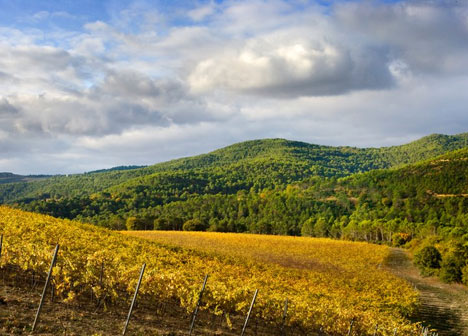 |
| (Source: Information Office of the D.O. Navarra) |
The wine-growing region extends over almost 12,000 hectares south of the regional capital Pamplona. With the exception of eight municipalities (see section "Quality system in Navarra"), it bears the protected designation of origin Denominación de Origen Protegida (DOP), which emerged in the course of the EU wine market reform from the Denominación de Origen (DO), which was the only designation valid until 2009. The DOP Navarra is divided into five different growing areas: Baja Montaña, Valdizarbe, Tierra Estella, Ribera Alta and Ribera Baja.
The history of viticulture in Navarre can be traced back to Roman times. Remains of an ancient form of the vine have even been found, estimated to be five million years old. Remains of ancient Roman cellars, tombs and amphorae bear witness to the social and economic importance of viticulture at that time. This importance continued under Moorish rule in the 8th century. When the first monasteries were founded in the 9th and 10th centuries and the Way of St James was established in the 11th century, which passes through Pamplona, the vineyards continued to spread. Cellar technology advanced in the monasteries, and pilgrims brought new vines to the region.
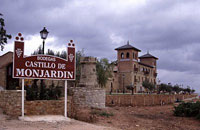 |
| (Source: Information Office of the D.O. Navarra) |
Navarre was already a major wine producer and exporter in the 14th century. The vineyard area probably reached its greatest extent at the beginning of the 15th century, even as far north as Pamplona. However, in order to feed the inhabitants of the Kingdom of Navarre, the cultivation of cereals gradually became more important than viticulture. In the mid-19th century, while phylloxera was ravaging France, the area under vines grew again for a time to around 50,000 hectares, as the neighbouring country wanted to continue to be supplied with wine. Within a few years, however, phylloxera also reached Navarre and destroyed 97 percent of the vineyard area there.
For a long time, Navarre was reduced to rosé wines made from the indigenous Garnacha grape. In the past two decades, however, wine styles have changed considerably - and continue to do so. Alongside the traditional grape varieties Viura, Tempranillo and Garnacha, international grape varieties such as Chardonnay, Cabernet Sauvignon and Merlot were introduced in the 1980s. The new varieties have adapted well to the conditions in the region and give many wines a new expression without displacing the traditional grape varieties.
The major changes began in the 1990s, when a few "restless" winemakers, who wanted to preserve and develop the region's winemaking tradition with ambition, quality awareness and experimentation in equal measure, introduced new practices and revolutionary concepts. In 2008, the Navarre Denomination of Origin celebrated its 75th anniversary, and since then a new regulation has encouraged further modernisation in the vineyard and cellar. Navarre exported around 151,200 hectolitres of wine in 2010, more than half of which went to European countries. The largest sales markets for Navarrese wines are Germany, the Netherlands, Great Britain and the USA.
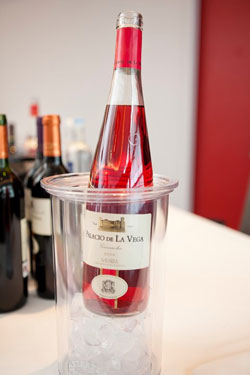 |
| (Source: Information Office of the D.O. Navarra) |
The wines of the DOP Navarra are 70 percent red and a quarter rosé - 94 percent of the area is planted with red varieties. The whites produced are predominantly sweet dessert wines. More than two-thirds of the vineyards are still planted with indigenous grape varieties.
The main red varieties in Navarre are Tempranillo (about one third), Garnacha, Cabernet Sauvignon, Merlot, Graciano and Mazuelo (Carignan), and recently also Syrah and Pinot Noir. Among the whites, Chardonnay, Viura, Moscatel (Muscatel) and Malvasía are the most important, complemented by Sauvignon Blanc. The range of wines and styles produced from these grapes is correspondingly wide.
The quality levels in the region include single vineyards as well as wines from three protected designations of origin (PDO) and two protected geographical indications (PGI):
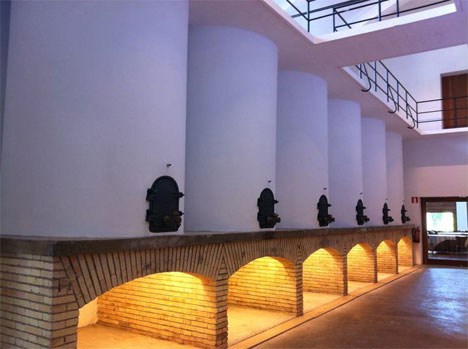 |
| (Source: Information Office of the D.O. Navarra) |
As already mentioned, the DOP Navarra is divided into five sub-areas, which will be briefly presented below.
Baja Montaña is located in the north-east of Navarre, on the border with Aragon, and comprises 22 municipalities. The capital of the sub-region is Sangüesa. In the hilly landscape with its lush undergrowth, viticulture dominates the few areas that can be used for agriculture. Around 2,400 hectares are planted with vines, mainly red varieties such as Garnacha (over 60 percent) and Tempranillo (25 percent). Climatically, the zone is located between the slightly humid north and the extremely dry south of the region. The annual rainfall varies between 760 and 470 millimetres, and due to the differences in altitude, the growing seasons of the vines are also different - just as in the other northern areas. In Baja Montaña, the Pyrenees have the greatest influence.
The reddish and yellowish soils, which often contain gravel and lime, have developed differently depending on the contour of the terrain and the parent material. Most of the slopes in the northern area have soils of varying depths, without stones and of heavy texture, on grey marl of the marine Eocene from the Lumbier Basin. In the rest of the area, the slopes have soils of varying weight and stoniness, either light and thin or clayey on alternating layers of marl and sand from the continental Tertiary of the Ebro Plain. In the valley bottoms and the remains of alluvial terraces along the rivers Irati and Aragón, gravelly soils predominate. Here the vines grow on deep, light soils with excellent water drainage.
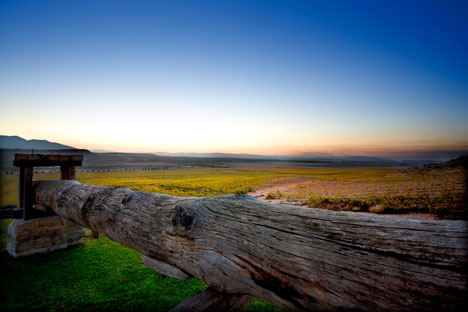 |
| (Source: Control Council of the D.O. Navarra) |
Valdizarbe is located at the junction of the Way of Saint James in the north of Navarre, south of the Pamplona basin. The sub-region, whose capital is Puente La Reina, comprises 25 municipalities and stretches in gentle hills and valleys mostly along the course of the river Arga. On the western side, the area is bordered by the foothills of the Sierra de Andía, on the northern side by the Sierra del Perdón. The vineyards cover an area of around 1,400 hectares, most of which are planted with Tempranillo, Garnacha, Cabernet and Merlot in almost equal proportions, plus some Chardonnay and Malvasía. Valdizarbe is climatically the northernmost point of the Navarre wine region and the wettest of all the sub-regions. The surrounding mountain massifs reduce the Atlantic influence, and the vineyards are located on the sunniest areas. Like Baja Montaña, Valdizarbe lies between the humid north and the dry south of Navarre. The annual rainfall varies between 807 and 544 millimetres.
The brown-limestone soils also show some diversity in Valdizarbe: on the slopes in the northernmost area, heavy, stoneless and of varying depths, again partly on grey marl; on the other slopes, in succession of marl and sand from the continental Tertiary, of varying depths and stony, with fine or silty clay, in some places with a characteristic red colour. As in the other areas, there are vineyards on alluvial soils from the remains of the terraces of the Arga and Salado rivers and the glacier from the Sierra del Perdón. The terrain is practically flat with good drainage, deep with a loamy texture and often stony.
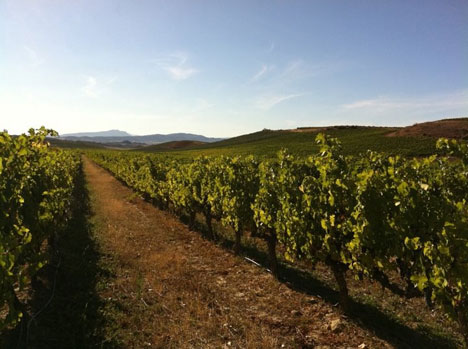 |
| (Source: Information Office of the D.O. Navarra) |
Tierra Estella stretches along the Way of Saint James in the northwest of Navarre. The sub-region with the capital Estella comprises 38 municipalities and borders on both the Basque Country and Rioja to the west. In the north, the Urbasa and Andía mountain ranges form the border and protect the area from Atlantic climatic influences. The landscape, crossed by the river Ega, flattens out from the mountainous north to the south. Tempranillo is grown on almost half of the approximately 3,000 hectares of vineyards, followed by Cabernet Sauvignon with 20 percent; the most widely grown white grape variety is Chardonnay. Tierra Estella also has a dry and semi-humid climate, annual rainfall varies between 700 and 454 millimetres, and the vineyards are preferably located in the sunniest places.
On the slopes of Estella and Lorca, there are deep, loamy soils on Triassic marl. In the rest of the hills, the soils vary in thickness and stoniness, with a fine or silty texture on alternating layers of marl, sand and a conglomerate from the continental Tertiary, some with a distinct red colour. In the alluvial valleys, the remains of the terraces of the Ega, Iranzu and Odrón rivers and the Montejurra glacier, the vines grow on fairly shallow, deep and often gravelly soils with a healthy texture.
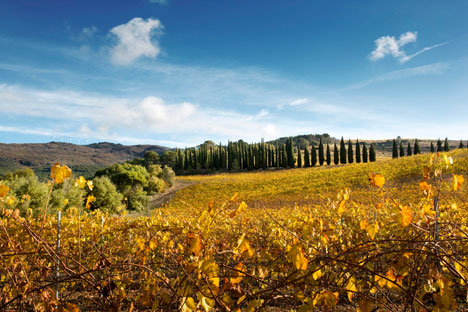 |
| (Source: Control Board of the D.O. Navarra) |
Ribera Alta is the central area of Navarre, at the transition to the south of the region, and includes 26 municipalities. With around 5,800 hectares, the sub-region occupies almost a third of the area of the Navarre PDO. Tempranillo is the predominant grape variety, but the other red varieties are also well represented, especially Graciano. Towards the north and around the river Ega, the area rises gently and flattens out towards the south. Ribera Alta is again made up of two parts: Around the town of Olite, which is also a focal point of viticulture, there is a transitional climate, while in the area of Lerín and Marcilla the climate is already distinctly dry. Due to the lack of influence from the Atlantic and the Pyrenees, this zone is hotter than the north. In the flat terrain, the climate transition is rather gradual. Average rainfall varies between 507 and 349 millimetres, and the vineyards suffer from a lack of water in summer.
The predominant soil type is calcareous marl, near rivers as alluvial soil with red and sandy patches. Most of the slopes consist of soils of varying density and stoniness, light and thin or clayey on alternating layers of marl and sand from the continental Tertiary, with the exception of some areas near Cárcar, Sesma, Lerín or Falces. There, the soils are shallow-textured with a clayey-loamy structure and a high proportion of gypsum when they overlie alternating layers of marl and gypsum. Deep soils are over Quaternary alluvial terraces of the Ega, Arga, Cidacos and Aragón rivers. The composition is light and often stony, which allows excellent water drainage. On the higher terraces, such as Monplanet in Olite or the Saso de Santacara, calcareous crusts are often found at shallow depths.
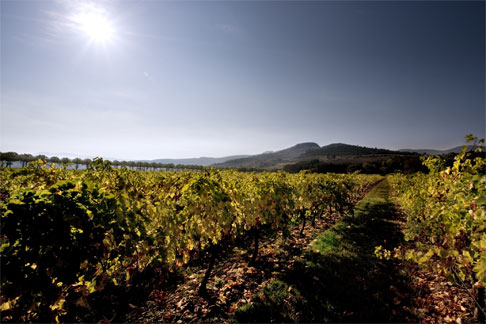 |
| (Source: Information Office of the D.O. Navarra) |
Ribera Baja is located in the south of Navarre, in the Ebro Valley between Aragon and Rioja. The sub-region with the capital Tudela comprises 14 municipalities and is situated in a large, very flat and sparsely vegetated plain dominated by the imposing Sierra del Moncayo. With around 5,200 hectares, Ribera Baja accounts for almost 30 percent of the area of the Navarre PDO. Tempranillo is the dominant red grape variety with 40 percent, followed by Garnacha with 30 percent. In addition, Ribera Baja represents the largest area under Viura and Moscatel in the region. The area is the driest zone in Navarre with a relatively constant semi-arid climate. The average annual rainfall varies between 361 and 384 millimetres, and even here the vines have to endure water shortages.
In the north of the area, brown-limestone soils predominate, while in the south, brown, grey, desert-like terrain prevails. A large part of the vines are planted on soils of different levels of the terraces of the river Ebro and its tributaries on the right bank, which date back to the Quaternary period. These are shallow, deep soils with a light, often stony structure. On the higher terraces, calcareous crusts occur at a shallow depth, as in Montes de Cierzo. In the southernmost part, on the slopes of the zone marked by Mount Moncayo, there are dense, sometimes stony soils with a muddy-clayey structure, on alternating layers of marl and sand, as well as conglomerates from the continental Tertiary of the Ebro plain.
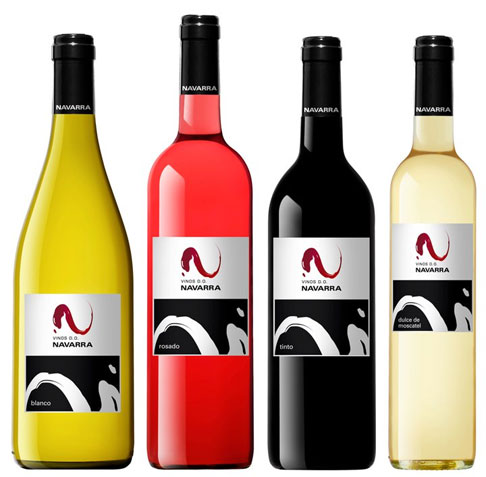 |
| (Source: Information Office of the D.O. Navarra) |
The following producers from the Navarra region have currently sent in wines for tasting:
Aroa BodegasZurukoain - Gorozin
Following the Roman winemaking tradition in the region, the Aroa winery was founded in 1998. Aroa in the Basque language means "the optimal time to work the land". The bodega is located in the Deierri valley in Tierra Estella, on a hill on the south-eastern side of the Apalaz mountain between the towns of Zurukuain and Gorozin. Here there are both Mediterranean and Atlantic climatic influences, as well as different soil structures, containing sandstone, limestone and clay in varying proportions. Bodega Aroa's 20 hectares of vineyards are divided between the three areas of Burunziain, Ernobeleta and Aritzarotz, where Tempranillo, Cabernet Sauvignon, Merlot and Garnacha, as well as Garnacha Blanca and Moscatel are grown.
Bodega de Sada, Sada
Founded in 1939, the Bodega de Sada is located in Baja Montaña. The winery has 600 hectares of its own vineyards in the Aragon River Basin, a third of which were planted more than 60 years ago. Mainly Garnacha is grown and the vines are on average 30 years old. In the winery, which covers a total area of five square kilometres, the wines are aged in cement or steel tanks and mature in French and American oak barrels.
Bodega de Sarría (Grupo Taninia), Puente La Reina
The land on which the Bodega de Sarría was built in 1953 had previously been used for wine growing for many centuries, thanks in part to the excellent climate and soil conditions in the Puente La Reina area. 210 hectares of vineyards stretch along the slopes and sunny areas of the Sierra del Perdón as well as Olite, Corella and Miranda de Arga. Tempranillo, Graciano, Mazuelo, Cabernet Sauvignon and Merlot are grown for red wines, Garnacha for rosés and Chardonnay for white wines. The vines of Merlot, Cabernet Sauvignon and Chardonnay are on average more than 20 years old, the Garnacha, Graciano, Tempranillo and Mazuelo vines have an average age of more than 50 years.
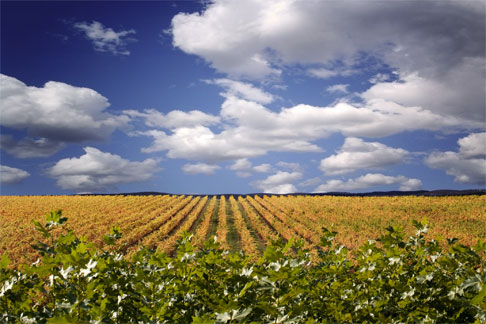 |
| (Source: Information Office of the D.O. Navarra) |
Bodega Inurrieta, Falces
The name Inurrieta refers to an estate on which the ancestors of the owner family already cultivated vines about a hundred years ago. In 1999, the first vines of today's bodega were planted. The 230 hectares of vineyards are located in the Ribera Alta in a small valley crossed by the river Arga, at 300 to 480 metres above sea level. At the first altitude level, between 300 and 325 metres above sea level, there are sandy and loamy soils with some scree, on which Merlot, Sauvignon Blanc, Cabernet Sauvignon and Graciano grow. At the second altitude level, between 325 and 375 metres, the soils are clayey and planted with Cabernet Sauvignon, Sauvignon Blanc, Garnacha and Syrah. At the third altitude level, between 375 and 480 metres, the soils are calcareous gravel and bear Cabernet Sauvignon, Graciano and Merlot. The winery's facilities, spread over 7,000 square metres, allow for integral control of the entire winemaking process and have been designed according to practical, hygienic, oenological and functional criteria. The wines mature in the air-conditioned cellar in French and American oak barrels.
Bodega Naparralde, Corella
The Naparralde facilities were already more than 25 years old when Juan Celaya Letamendi founded the current winery there in 2006 and equipped it with state-of-the-art cellar technology. He brought his more than thirty years of professional experience to the new bodega and pursued the highest quality standards from the very beginning. His wines are characterised by rich fruit, targeted use of barriques and long bottle ageing.
Bodegas Ochoa, Olite
The Ochoa family has been dedicated to winegrowing in Navarre since the 14th century. Currently, Javier Ochoa and Mariví Alemán continue the tradition with their daughters Adriana and Beatriz. The current winery buildings are more than 160 years old and were extensively modernised in 1992. Ochoa practices integrated viticulture while using new technologies and participating in research projects. Javier Ochoa was also responsible for the Navarre EVENA Viticulture and Enology Institute from 1980 to 1992. The winery cultivates 143 hectares of vineyards with Tempranillo, Cabernet Sauvignon and Merlot and vinifies its red wines in American and French oak barriques. A traceability programme allows the development of all wines to be observed and controlled throughout the entire winemaking process.
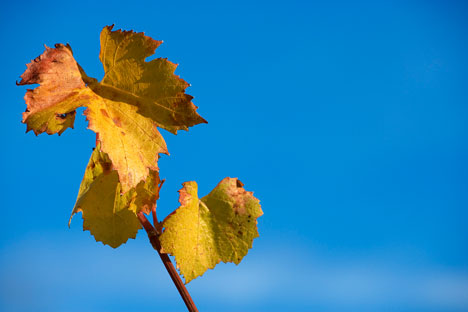 |
| (Source: Control Board of the D.O. Navarra) |
Bodegas Piedemonte, Olite
In 1992, a group of quality-oriented winegrowers joined forces to form Bodegas Piedemonte, which today cultivates 352 hectares. The vineyards extend over different areas of the Ribera Alta and are planted with the Spanish varieties Garnacha, Tempranillo, Graciano and Viura as well as with the French varieties Merlot, Cabernet Sauvignon and Chardonnay. In addition, sweet wines are produced from Moscatel grapes. The region has a continental climate with dry summers, and the soils are clayey and stony. The vineyards are often planted in terraces. In the modern production facility, the wines ferment in temperature-controlled stainless steel tanks and mature in oak barrels (barricas) in a fully air-conditioned cellar.
Castillo de Monjardín, Villamayor de Monjardín
The winery in the valley of San Esteban in Tierra Estella has been in existence since 1986. The current winery with an area of 4,000 square metres was built in 1994 and operates according to environmentally friendly principles. At an altitude of 400 to over 600 metres above sea level, Chardonnay, Tempranillo, Cabernet Sauvignon and Merlot are cultivated on 220 hectares. Castillo de Monjardín also has the oldest Pinot Noir vineyard in Navarre, planted in 1998. The vineyards, many of which have clay soil, are located on sunny slopes where they benefit from the coolness of the Cierzo wind in the hot summers.
Señorío de Otazu, Echauri
Located in the Cuenca de Pamplona basin, between the Sierra del Perdón and the Sierra de Echauri, Señorío de Otazu is Spain's northernmost red wine producing area. The area has been classified as Vino de Pago since 2009 and is owned by the winery of the same name. The area has been agriculturally, culturally and historically linked to viticulture since the 12th century. The climate is continental with Atlantic influences, plenty of sun in the summer months and sufficient rain in winter. The Bodega Señorío de Otazu grows Tempranillo, Merlot, Cabernet Sauvignon and Chardonnay on 115 hectares of vineyards. The vines grow on a mixture of clayey alluvial terraces, scree and rock.
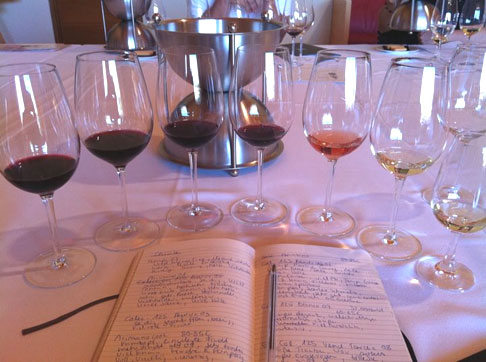 |
| (Source: Information Office of the D.O. Navarra) |
Bodegas Vega del Castillo, Olite
In 1999, the Bodega Cooperativa Olitense in Olite, the Unión de Cooperativas Virgen de Ujué in Ujué and the Cooperativa Vinícola Nuestra Señora de Ujué in Pitillas joined forces to form the Bodegas Vega del Castillo. The members of the cooperative cultivate 915 hectares according to technical bodega guidelines. Due to the scattered location of the vineyards in the sub-regions of Baja Montaña, Ribera Alta and Ribera Baja, the range of wines is very differentiated. The grapes grown are Garnacha (45 percent, many of which are over 80 years old), Viura, Tempranillo, Cabernet Sauvignon and Merlot.
Devicius Wines, Olite
Devicius Wines stands for wines that combine origin and drinking pleasure. Company founder Matthias Pawlitta has travelled widely in the (wine) world as an oenologist and globetrotter. The desire for self-realisation gave birth to the idea of making good wines for friends in Spain - called Devicius after the Spanish "de vicio" for "sinfully good". The basis of Devicius wines are carefully selected grapes, which produce very different initial wines depending on the landscape, location, soil and climate. In cooperation with like-minded winegrowers and wineries, these wines are vinified and combined into the Devicius cuvées.
Guelbenzu (Grupo Taninia), Vierlas
The history of Bodega Guelbenzu dates back to the middle of the 19th century, with the winery experiencing a major boost with the inauguration of its new winery in Vierlas in 2001. Vierlas is located in the IGP Ribera de Queiles region, on the border between the wine-growing regions of Navarre and Aragon. Meanwhile, Guelbenzu belongs to the Navarrese Taninia Group and has 46 hectares of vineyards in Lombana, where Merlot (almost a third of the area), Cabernet Sauvignon, Syrah, Tempranillo, Graciano, Petit Verdot and Garnacha are cultivated. The stony, infertile soil is not susceptible to drought or frost and favours low yields. Strong, dry, cool north winds protect the vines from moisture-induced rot, and the proximity to Moncayo Mountain allows the grapes to ripen slowly and well due to high temperature differences between day and night.
All currently tasted wines from Navarra in the wine guide